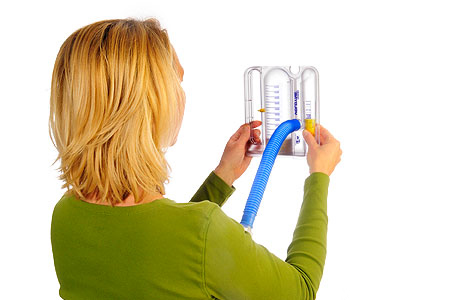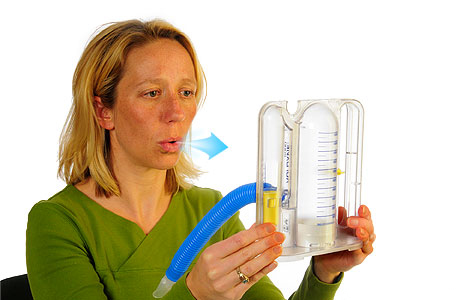Our Health Library information does not replace the advice of a doctor. Please be advised that this information is made available to assist our patients to learn more about their health. Our providers may not see and/or treat all topics found herein.
How to use a manual incentive spirometer
When you use an incentive spirometer, you'll breathe in air through a tube that is connected to a large air column containing a piston or ball. As you breathe in, the piston or ball inside the column moves up. The height of the piston or ball shows how much air you breathed in. You may feel lightheaded when you breathe in deeply for this exercise. If you feel dizzy or like you're going to pass out, stop the exercise and rest.
Each time you do this exercise, keep track of your progress by writing down how high the piston or ball moves up the column. This will help you and your doctor know how well your lungs are working.
Move the slider.

Move the slider on the outside of the large column to the level that you want to reach or that your doctor recommended.
Hold the spirometer in front of you.

Sit or stand up straight, and hold the spirometer in front of you. Be sure to keep it level.
Breathe out.

To start, breathe out normally.
Then close your lips tightly around the mouthpiece. Make sure that you don't block the mouthpiece with your tongue.
Breathe in.

Take a slow, deep breath. Breathe in as deeply as you can. As you breathe in, the piston or ball inside the large column will move up. Try to move the piston or ball as high up as you can or to the level your doctor recommended.
When you can't breathe in anymore, hold your breath for 2 to 5 seconds.
Breathe out.

Relax, remove the mouthpiece, and then breathe out normally.
Repeat steps 1 through 5 as many times as your doctor tells you to. Then go to the step 6.
Cough.

After you've taken the recommended number of breaths, try to cough a few times. This will help loosen any mucus that has built up in your lungs. It will make it easier for you to breathe.
If you just had surgery on your belly or chest, hold a pillow over your incision when you cough. This will support your belly or chest and reduce your pain.
Repeat these steps as many times a day as your doctor tells you to.
Current as of: September 29, 2025
Author: Ignite Healthwise, LLC Staff
Clinical Review Board
All Ignite Healthwise, LLC education is reviewed by a team that includes physicians, nurses, advanced practitioners, registered dieticians, and other healthcare professionals.
This information does not replace the advice of a doctor. Ignite Healthwise, LLC disclaims any warranty or liability for your use of this information. Your use of this information means that you agree to the Terms of Use and Privacy Policy. Learn how we develop our content.
To learn more about Ignite Healthwise, LLC, visit webmdignite.com.
© 2024-2025 Ignite Healthwise, LLC.


